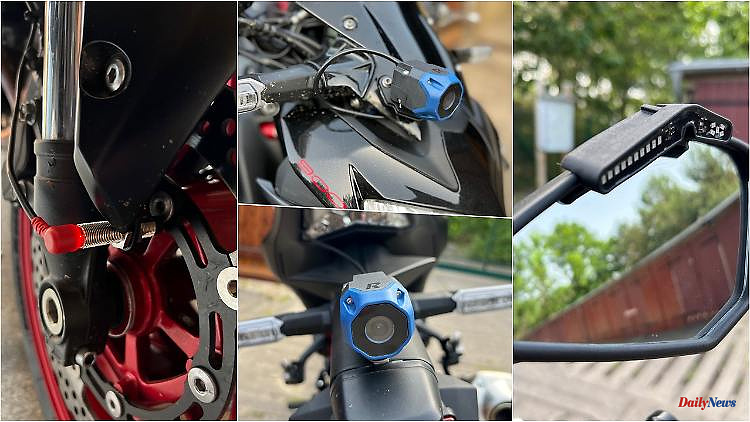Blind spot, distance to the vehicle in front or collision warning: until now, motorcyclists were responsible for their own safety. The Israeli company Ride Vision has now developed a system of the same name for self-assembly, which is intended to relieve the driver here. But that's not entirely without it.
Anyone who buys a new car these days usually also buys a whole arsenal of assistance systems. The distance to the car in front is measured, warnings are given of vehicles in the blind spot or of an imminent collision. These little helpers are rather alien to motorcyclists. In fact, there are currently very few manufacturers who offer such extensive security systems. The Israeli company Ride Vision recognized this gap and developed a retrofit kit under the same name to close it.
The assistance and warning system includes two wide-angle cameras to be permanently mounted on the front and rear, warning LEDs that need to be attached to the side mirrors, a sensor that is mounted on the front wheel and a control unit that processes all the information and, in the end, for the corresponding ones information. That sounds manageable and the company Ride Vision also sells the kit, which costs at least 500 euros, for self-assembly. However, the attachment with the lavish cabling and the attachment requirements for the wide-angle cameras and the wheel sensor is not that easy.
In fact, the author of these lines was sent a specialist from Israel to help install the individual components, and without whom it would probably have ended in disaster. Because it's not as easy as the manufacturer claims. Not even if the corresponding adhesive materials are already supplied with fairly straightforward assembly instructions. Nevertheless, the cameras, for example, require a clear view and must be attached to the bow and stern in such a way that the clear view is not disturbed by anything.
That brings other troubles. At least for people who love the lines of their bikes: they are severely disturbed by the camera eyes, which are not exactly small, and the cables connecting them to the control unit. Especially with naked bikes or even racing machines, the whole thing seems a bit artificial in the truest sense of the word. The eyes can be better hidden by the slightly different facings on Enduro models. Admittedly, due to the safety features to be expected, personal vanity should be put in the background with a view to the motorcycle, but somehow it hurts the soul. Even when you know that there is currently no system as sophisticated as that of Ride Vision, even for series production motorcycles.
But if the cable for the rear camera comes out of the rear light and there is a gap right there that is a gateway for moisture of any kind, then you should think again about the installation idea. Because here it is accepted that moisture penetrates under the seat. In exactly the same place where the battery is located on most motorcycles. The control unit itself must then also be connected to it. Sure, because the part needs electricity to work. And here the author was on the verge of heartbreak for a moment when the colleague from Israel used the cutter to open the insulation of the battery's main line in order to wire the control unit to it and then also solder it.
The wiring of the LEDs mounted on the mirrors with the locking with cable ties does not really flatter the eye of the aesthete. Especially since the complete side paneling has to be removed to move it in the direction of the control unit. So again: The assembly of the system is not without its problems and actually has its pitfalls, which the layman can certainly fail at. In this respect, Ride Vision should reconsider the application with the sentence "easy assembly". The manufacturer says: "We found that most motorcyclists are real screwdrivers and have no problems with such an assembly." Well, the author is not one of them.
But in the end, thanks to the nice colleague from Israel, everything is there and it works really well. As proof of this, two yellow light-emitting diodes in the relevant side mirror flash briefly when starting off. However, to the surprise of the author, nothing happens when rolling to the intersection. The car is barely two meters away. Everything is correct, explains the specialist from Ride Vision, the system only reacts from a speed of 40 km/h. Instead, the outer yellow LED on the left mirror suddenly lights up and warns of a VW Touran appearing in the blind spot, in order to then quickly pass your own motorcycle. This is helpful because the lamp is faster than looking over the shoulder.
On country roads and motorways, however, a kind of light organ flickering begins when driving quickly and on crowded roads. The red LEDs on both mirrors flash frantically and issue one collision warning after the other. Because that's really annoying and the flickering doesn't stop even when overtaking, the next stop is used for adjustment. Ride Vision supplies an app with the system for control. As long as the control unit is powered, i.e. as long as the ignition is on, the sensitivity of the warnings can be set here, as can the brightness of the LEDs.
Now that the wild blinking has been reduced and the LEDs no longer blind the eyes, the system is becoming quite helpful. Because yes, in the end you pay different attention when riding a motorbike than when you just dawdle in the car. But should you fail to notice the person driving ahead or even turning off, then the flash of light is a tried and tested means of yanking on the brakes in good time and coming to a standstill before a possible collision. The LEDs also warn you if vehicles are driving too close to your own motorcycle from behind.
If it really crashes, the recording of the two cameras can be very helpful. But it is better to watch the films for personal entertainment after the ride. In fact, the two cameras work like a dash cam. However, Ride Vision assures that the recordings that end up on a server will be deleted within three hours if they are not downloaded by the user. Because in combination with the data also stored in the app, such as distance, maximum speed reached, lean angle and number and type of warnings, it may not always be helpful for the sporty driver. Incidentally, the latter data apart from the films is only stored on the user's smartphone and can also be irretrievably deleted there at any time.












